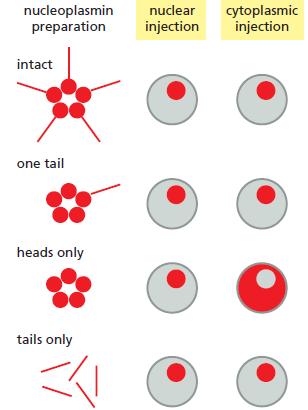Before nuclear pore complexes were well understood, it was unclear whether nuclear proteins diffused passively into the
Question:
Before nuclear pore complexes were well understood, it was unclear whether nuclear proteins diffused passively into the nucleus and accumulated there by binding to residents of the nucleus such as chromosomes, or whether they were actively imported and accumulated regardless of their affinity for nuclear components.
A classic experiment that addressed this problem used several forms of radioactive nucleoplasmin, which is a large pentameric protein involved in chromatin assembly. In this experiment, either the intact protein or the nucleoplasmin heads, tails, or heads with a single tail were injected into the cytoplasm of a frog oocyte or into the nucleus (Figure Q12–1). All forms of nucleoplasmin, except heads, accumulated in the nucleus when injected into the cytoplasm, and all forms were retained in the nucleus when injected there.
A. What portion of the nucleoplasmin molecule is responsible for localization in the nucleus?
B. How do these experiments distinguish between active transport, in which a nuclear localization signal triggers transport by the nuclear pore complex, and passive diffusion, in which a binding site for a nuclear component allows accumulation in the nucleus?
Figure Q12-1

Step by Step Answer:

Molecular Biology Of The Cell
ISBN: 9780815344322
6th Edition
Authors: Bruce Alberts, Alexander D. Johnson, Julian Lewis, David Morgan, Martin Raff, Keith Roberts, Peter Walter





